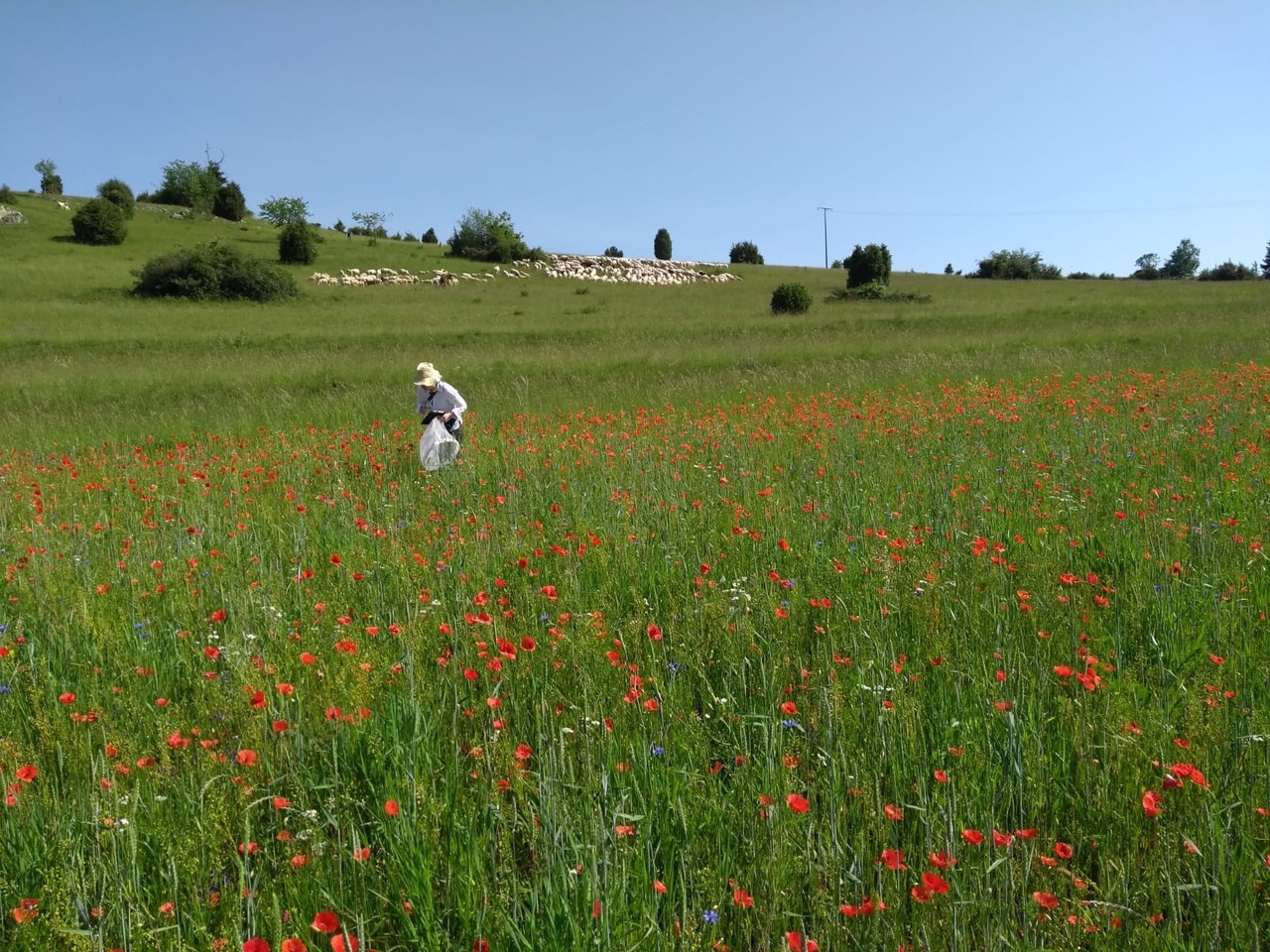Scientific projects
Bees and flowers evolved in a close relationship. In this interaction, flowers often provide cues such as odour and colour that bees use to find and recognize the flowers. I am highly interested in the communication process between flower-visiting insects and flowers. I investigate the behaviour-mediated volatiles involved in host finding by flower-specialist (oligolectic) bees.
Wild bees are among the most important pollinators of wild and cultivated plant species but suffer from ongoing land use intensification. The dynamics behind the ongoing wild bee declines are often hard to spot, as they are caused by multiple, interacting, and sometimes synergistic factors. As a scientific member of the BienABest project I am currently investigating the biodiversity of wild bees. The project aims to develop procedures to stop the drastic decline of wild bee populations and to protect and extend the ecosystem service "Pollination by Wild Bees".
Publications
Burger H, Buttala S, Koch H, Ayasse M, Johnson SD, Stevenson PC (2024). Nectar cardenolides and floral volatiles mediate a specialized wasp pollination system. J. Exp. Biol. 227(1): jeb246156. https://doi.org/10.1242/jeb.246156
Heuel KC, Ayasse M and Burger H (2024). Bee-diverse habitats positively affect seed set in wild plant species. Front. Ecol. Evol. 12:1343885. https://doi.org/10.3389/fevo.2024.1343885
Kuppler J, Neumüller U, Mayr AV, Hopfenmüller S, Weiss K, Prosi R, Schanowski A, Schwenninger HR, Ayasse M, Burger H (2023). Favourite plants of wild bees. Agriculture, Ecosystems & Environment 342: 108266. https://doi.org/10.1016/j.agee.2022.108266
Lukas K, Dötterl S, Ayasse M, Burger H (2023). Colletes hederae bees are equally attracted by visual and olfactory cues of inconspicuous Hedera helix flowers. Chemoecology 33: 135-143. https://doi.org/10.1007/s00049-023-00392-0
Herrera-Mesías F, Bause C, Ogan S, Burger H, Ayasse M, Weigand AM, Eltz T (2022). Double-blind validation of alternative wild bee identification techniques: DNA metabarcoding and in vivo determination in the field. Journal of Hymenoptera Research 93: 189-214. https://doi.org/10.3897/jhr.93.86723
Neumüller U, Burger H, Mayr AV, Hopfenmüller S, Krausch S, Herwig N, Burger R, Diestelhorst O, Emmerich K, Haider M, Kiefer M, Konicek J, Kornmilch J-C, Moser M, Saure C, Schanowski A, Scheuchl E, Sing J, Wagner M, Witter J, Schwenninger HR, Ayasse M (2022). Artificial Nesting Hills Promote Wild Bees in Agricultural Landscapes. Insects. 13(8): 726. https://doi.org/10.3390/insects13080726
Burger H, Joos N, Ayasse M (2021). Floral Cues of Non-host Plants Attract Oligolectic Chelostoma rapunculi Bees. Front Ecol Evol 9: 682960. https://doi.org/10.3389/fevo.2021.682960
Burger H, Marquardt M, Babucke K, Heul KC, Ayasse M, Dötterl S, Galizia CG (2021). Neural and behavioural responses of the pollen-specialist bee Andrena vaga to Salix odours. J Exp Biol 224(13). https://doi.org/10.1242/jeb.242166
Neumüller U, Burger H, Schwenninger HR, Hopfenmüller S, Krausch S, Weiß K, Ayasse M (2021). Prolonged blooming season of flower plantings increases wild bee abundance and richness in agricultural landscapes. Biodiversity and Conservation 30: 3003-3021. https://doi.org/10.1007/s10531-021-02233-4
Neumüller U, Burger H, Krausch S, Blüthgen N, Ayasse M (2020). Interactions of local habitat type, landscape composition and flower availability moderate wild bee communities. Landscape Ecology 35: 2209-2224. https://doi.org/10.1007/s10980-020-01096-4
Peuker MA, Burger H, Krausch S, Neumüller U, Ayasse M, Kuppler J (2020). Floral traits are associated with the quality but not quantity of heterospecific stigmatic pollen loads. BMC Ecol 20: 54. https://doi.org/10.1186/s12898-020-00323-5
Lukas K, Dötterl S, Ayasse M, Burger H (2020). Olfactory and visual floral signals of Hedera helix and Heracleum sphondylium involved in host finding by nectar-foraging social wasps. Front Ecol Evol 8: 571454. https://doi.org/10.3389/fevo.2020.571454
Burger H, Jürgens A, Ayasse M, Johnson SD (2017). Floral signals and filters in a wasp- and a bee-pollinated Gomphocarpus species (Apocynaceae: Asclepiadeae). Flora 232: 83-91. https://doi.org/10.1016/j.flora.2017.05.009
Burger H, Ayasse M, Dötterl S, Kreissl S, Galizia CG (2013). Perception of floral volatiles involved in host-plant finding behaviour: comparison of a bee specialist and generalist. J Comp Physiol A 199: 751-761. https://doi.org/10.1007/s00359-013-0835-5
Burger H, Dötterl S, Häberlein CM, Schulz S, Ayasse M (2011). An arthropod deterrent attracts specialised bees to their host plants. Oecologia 168: 727-736. https://doi.org/10.1007/s00442-011-2136-4
Burger H, Dötterl S, Ayasse M (2010). Host-plant finding and recognition by visual and olfactory floral cues in an oligolectic bee. Funct Ecol 24: 1234-1240. https://doi.org/10.1111/j.1365-2435.2010.01744.x
Burger H, Ayasse M, Häberlein CM, Schulz S, Dötterl S (2010). Echium and Pontechium specific floral cues for host-plant recognition by the oligolectic bee Hoplitis adunca. S Afr J Bot 76: 788-795. https://doi.org/10.1016/j.sajb.2010.08.003
Burger H, Dötterl S, Ayasse M (2009). Importance of olfactory and visual cues of Echium for host-plant finding of the oligolectic bee Osmia adunca (Megachilidae). Mitt Dtsch Ges allg angew Ent 6: 163-166.
Contact
- Dr. Hannah Burger
- Institute of Evolutionary Ecology and Conservation Genomics
- Ulm University
- Albert-Einstein-Allee 11
- D-89081 Ulm, Germany
- Tel. +49 (0)731 50 22691
- Office: M25 4113
Email: info()hannah-burger.de

